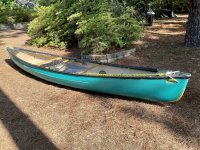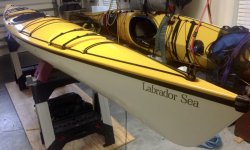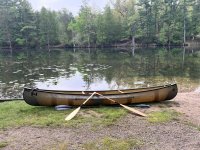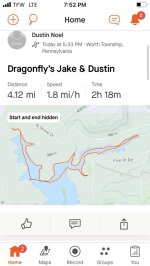-
Happy Birthday, Marilyn Monroe (1926-62)! 🎥⭐👩🏼👄👠👗
You are using an out of date browser. It may not display this or other websites correctly.
You should upgrade or use an alternative browser.
You should upgrade or use an alternative browser.
What are your current solo canoes and how do you like them?
- Thread starter Glenn MacGrady
- Start date
I have 2 dedicated solos, a mid-90s kevlar Wenonah Prism and a Northstar Phoenix in IXP layup. Very different boats, both fantastic, both will remind you to keep your head between the gunwales! However, my most often used at this point is a Northstar Polaris that I paddle from a center seat with kids fore and aft. Aside from some occasional paddle dipping by the kiddos, I’m paddling it solo. I love this boat!
My current solo is a DIY SOF as documented at This thread. (Note: Not the right way to do a SOF. There are some lovely boats out there. This isn't one of them.)
TLDR; nominal 13' X 30", 24" waterline. Fishform, 2.4" bow rocker, 1.8" stern rocker. Sharpish stems.
How do I like it? This build was always a bit of a disappointment:
TLDR; nominal 13' X 30", 24" waterline. Fishform, 2.4" bow rocker, 1.8" stern rocker. Sharpish stems.
How do I like it? This build was always a bit of a disappointment:
- Never very stiff. Flexes under pretty much every type of load. This leads to some unpredictability in performance.
- The interior framing and floorboards kicked my mass just a bit high, and I never could shift weight to heel for maneuvering.
- While I never expected this build to be tough for tripping, it feels more fragile than I anticipated. I just don't trust it in conditions that I want to paddle in.
- Joined
- Jan 9, 2024
- Messages
- 4
- Reaction score
- 5
Savage River Blackwater, expedition layup (uni-biaxial carbon fiber and an extra inside layer of Kevlar); all carbon gunwales, seat, thwarts, etc.; lots of little personal outfitting bits and pieces like partial spray decks, paddle holders, and so on. It's a few years old but new to me, so I'm crazy about it right now. Got up at 6:30 this morning so I could paddle before work. Can't wait to do it again tomorrow!
Bergen's Ally Pakcanoe solo 15. I like the size and packability, and it's nicely made. It seems very capable, and would be great for a big fly-in trip way up North. It takes maybe half an hour to assemble. It's not that compact when packed up. The seat seems to be made for kneeling, and I like sit-and-switch. So I'll probably sell it some time this year.
Bergen's Ally Pakcanoe solo 15. I like the size and packability, and it's nicely made. It seems very capable, and would be great for a big fly-in trip way up North. It takes maybe half an hour to assemble. It's not that compact when packed up. The seat seems to be made for kneeling, and I like sit-and-switch. So I'll probably sell it some time this year.
In response to @Glenn MacGrady's question in the photos thread, that is in fact my new-to-me SRT. I've put probably about 15 miles on it at this point, enough for a semi-informed initial impression.
Where I've paddled it so far: open lake, labyrinthine marshy foot of a lake, a short riffle-y section of river, and a long stretch of winding creek. All trips were with the boat essentially empty.
What I've found:
Where I've paddled it so far: open lake, labyrinthine marshy foot of a lake, a short riffle-y section of river, and a long stretch of winding creek. All trips were with the boat essentially empty.
What I've found:
- The boat is stable, predictable, and efficient (not a speedster, but it provides a pleasant ratio of energy input to distance output) .
- On an open windy lake, it catches the wind like crazy, but feels less sketchy in those conditions than my low-riding MR Indy.
- It is the most enjoyable boat I've paddled in winding marsh/creek conditions, and I'm only beginning to get the hang of how it's designed to carve and turn.
- In quicker water, the boat seems no more or less apt than the Indy to remind me that I have an awful lot to learn, but it will remind me.
- My feet fit comfortably under the seat and I don't have to do any weird gymnastics to get into/out of the kneeling seat. Hallelujah!
- Thanks to the widest point of the boat not being at the gunwale, it required a tweak in the mechanics of my paddle stroke (I kept knocking my thumb knuckle on the hull for the first 20 minutes or so I paddled it).
- Where my weight is in the boat matters - I can't just lazily plop down off center and expect it to not have some effect on how the boat handles. I got used to sitting well off to the right side of the seat in my Indy, and when I first paddled the SRT I was wondering why the boat felt like it was pulling ever so slightly to the left. Moved my butt to the center of the seat, and the slight pull vanished. Makes me wonder even more about the Hemlock bucket seat, despite my general dislike of bucket seats.
- None of the paddles I have really fit me in the SRT, and with all my forays into the shallows and creeks I'm really abusing the delicate Grey Owl clearly intended for lake travel that is the closest fit. (Suggestions welcome).
- The 4ish pound difference between the Indy (heavier) and the SRT is suprisingly noticable when lifting the SRT overhead.
Anyone else fans of the Winter’s solos?
I can't think of a Winters canoe I didn't like. Asymmetry and cutting edge designs. I have a Winisk. Too bad Swift has retired all his designs in favor of softer ones. I wonder if John Winters is still with us.
My boat collection includes 2 Winters solos. Both were purchased used and they’ve come to be among my favorites to paddle.Had the birds out for spring maintenance today and they posed for this picture. The Raven looks huge next to the Osprey, which is not a small boat. Anyone else fans of the Winter’s solos?
Swift Raven canoe and Swift Labrador Sea touring sea kayak.


1. Cedarstrip 16' tandem, which really works better as a solo canoe, built around 1975 by a home town friend self-employed in the canoe making business. Have tripped with it hundreds of miles.
2. Cedarstrip 16' guideboat, by the same boat builder, nominally a tandem but more often used solo. Good for fishing.
3. Hornbeck 10.5 carbon/kevlar hybrid, the very first boat out of the shop of the model series built by Peter Hornbeck.
4. Hornbeck 12' kevlar, gifted to me by a late dear friend outdoor buddy.
5. Hornbeck carbon 14', found practically unused, couldn't pass up the ridiculously low price (1/5th full value) by someone needing to get rid of it because of moving to Florida that very day. Saving for when my daughter and grandaughter visit lake camp.
6. Placidboat First Gen Rapidfire, wood gunwales, high sliding racer seat, used for tripping, lake/river paddling and single blade training when larger race team is unavailable, and occasionally used for past solo racing.
7. Swift Cruiser 15.8, secondary solo training canoe with customized high sliding racing seat. Not yet raced or tripped in it. Seems to have very similar performance to the Rapidfire. Was built and personally delivered to my home by Bill Swift within 30 days of order.
8. Placidboat Shadow, long wanted for racing and training with custom racer higher than highest standard optional seat, faster (and much tippier) than the others. One year+ build/delivery time.
The Shadow, I am convinced, was created by PB to outrace all of the previous years many Rapidfires sold. I have only had the Shadow for a poor weather week to train in it before its first Saranac Lake Race. Finished respectably ok, but I do need more training in it before the next race.
I very much dislike using a kayak paddle with any Canoe, solo or other, although the solo rec race class rules require double blade use. Most Hornbecks are basically stuck with a double due to bottom seating position. In all other cases my solo canoes will be 99% (except when solo rec racing) paddled by me with a single blade Canoe paddle.
My carbon/kevlar Hornbeck is my favored lightweight pack canoe, having transported me on a 185 mile trek (including 62 miles of portages), diagonally crossing the Adirondacks, and tripped with many pond to pond backcountry bushwhack trek travels as well. Best for its light weight and especially for its short length when bushwhacking through dense woodlands.
2. Cedarstrip 16' guideboat, by the same boat builder, nominally a tandem but more often used solo. Good for fishing.
3. Hornbeck 10.5 carbon/kevlar hybrid, the very first boat out of the shop of the model series built by Peter Hornbeck.
4. Hornbeck 12' kevlar, gifted to me by a late dear friend outdoor buddy.
5. Hornbeck carbon 14', found practically unused, couldn't pass up the ridiculously low price (1/5th full value) by someone needing to get rid of it because of moving to Florida that very day. Saving for when my daughter and grandaughter visit lake camp.
6. Placidboat First Gen Rapidfire, wood gunwales, high sliding racer seat, used for tripping, lake/river paddling and single blade training when larger race team is unavailable, and occasionally used for past solo racing.
7. Swift Cruiser 15.8, secondary solo training canoe with customized high sliding racing seat. Not yet raced or tripped in it. Seems to have very similar performance to the Rapidfire. Was built and personally delivered to my home by Bill Swift within 30 days of order.
8. Placidboat Shadow, long wanted for racing and training with custom racer higher than highest standard optional seat, faster (and much tippier) than the others. One year+ build/delivery time.
The Shadow, I am convinced, was created by PB to outrace all of the previous years many Rapidfires sold. I have only had the Shadow for a poor weather week to train in it before its first Saranac Lake Race. Finished respectably ok, but I do need more training in it before the next race.
I very much dislike using a kayak paddle with any Canoe, solo or other, although the solo rec race class rules require double blade use. Most Hornbecks are basically stuck with a double due to bottom seating position. In all other cases my solo canoes will be 99% (except when solo rec racing) paddled by me with a single blade Canoe paddle.
My carbon/kevlar Hornbeck is my favored lightweight pack canoe, having transported me on a 185 mile trek (including 62 miles of portages), diagonally crossing the Adirondacks, and tripped with many pond to pond backcountry bushwhack trek travels as well. Best for its light weight and especially for its short length when bushwhacking through dense woodlands.
Had a Swift 14' Prospector pack boat in carbon fibre. I didn't like the kayak style seating as it was too low for me to get in an out of at wet portages. I'm too old to bend like that anymore, so I traded to a Swift Prospector 14' traditional web seat, in Kevlar Fusion with carbon gunwales. Both boats have kevlar skid plates and both weigh 30 pounds - the pack boat seat base offset the lighter carbon material.
Previously, I had a Nova Craft, Trapper 12'. It was a study little boat but was just a bit heavy (42#) portaging and getting on the roof of my F150. Twelve pounds makes a lot of difference over a 1,000 mete portage or a holding overhead to load on a roof in a strong wind.

Previously, I had a Nova Craft, Trapper 12'. It was a study little boat but was just a bit heavy (42#) portaging and getting on the roof of my F150. Twelve pounds makes a lot of difference over a 1,000 mete portage or a holding overhead to load on a roof in a strong wind.

I have only one, an Old Town Canadienne in kevlar. It is the shorter model 15'7" converted to solo configuration. It is a rocket with a 32 inch beam but it feels tender to me after paddling tandems solo for 50 years.
A few days ago, a frequent race paddling partner of one of my good friend Yukon River race team members called me to ask if I would evaluate a potential problem with his brand new Savage River Blackwater solo canoe. He had just acquired it, new, and it seemed to have a strong left turn drift bias whenever or however he paddled it using a single blade carbon racing paddle. He wasn't sure if it was his technique or the boat itself, so he asked if I would be interested in making an evaluation of it with my stroke. Since the Blackwater had for some time been on my potential acquisition list, I leaped at the chance and invited him to my lakeside camp. Long story short, I absolutely loved paddling the Blackwater. I could detect no turn bias, no matter how I paddled it. It is incredibly fast, I think a good bit faster as well as much more stable than my recently acquired Placidboat Shadow, which makes me nervous in waves and wind. Any stroke that I tried, including the Canadian with a straight wood paddle, made it perform exactly as I commanded. I observed my friend's strokes on both sides and seating position, but could not detect what caused his perceived left turn problem.
The only negative aspect of the BW is it is 17’ long, which is a foot too long to qualify to race in the solo-Rec class race that I bought the slightly shorter Shadow for. But the Blackwater is a beauty to fall in love with for training and certainly has enough volume and capacity and performance for tripping and is generally a lot of fun to paddle in any mode.
Since I have just reached the age when my first required 401(k) RMD mandatory distribution is due to be withdrawn this year, I have already contacted Ben Diller at Savage River.
The only negative aspect of the BW is it is 17’ long, which is a foot too long to qualify to race in the solo-Rec class race that I bought the slightly shorter Shadow for. But the Blackwater is a beauty to fall in love with for training and certainly has enough volume and capacity and performance for tripping and is generally a lot of fun to paddle in any mode.
Since I have just reached the age when my first required 401(k) RMD mandatory distribution is due to be withdrawn this year, I have already contacted Ben Diller at Savage River.
Last edited:
My Phoenix tends to go left when I coast. I need to play with weight placement, I postulate that a little more weight towards the stern would trim it better. Perhaps I am slightly plowing with a dry bag in front of me and nothing else in the boat?
- Joined
- Nov 30, 2017
- Messages
- 711
- Reaction score
- 469
I paddled a Colden Dragonfly on my trip last summer on the Cree River in SK. I found it to be an excellent loaded tripping boat and it rides the waves beautifully. It wants to be paddled from a kneeling position and I have found it the most comfortable canoe to paddle all day without changing positions. Knee pads all the time and thigh straps as necessary. It does not paddle as well without a load. It has poor primary stability but excellent secondary stability. I find it difficult to get in and out of, but obviously managed to do so as I am still here.
My Trillium seems to do well with my pack behind the seat, whether a daypack or a full pack. Sometimes I move it just a bit tighter in, or a little further back; also I often take the pouch I usually have for my camera, binoculars, and other misc. essentials out of the pack and put in in front a ways, and in certain winds move that more forward (might be placebo effect thinking that helps, but I'll take it).My Phoenix tends to go left when I coast. I need to play with weight placement, I postulate that a little more weight towards the stern would trim it better. Perhaps I am slightly plowing with a dry bag in front of me and nothing else in the boat?
Are you leaning to the left? That would do it. Lightening the bow would help too if it is digging in, even if you are leaning.My Phoenix tends to go left when I coast. I need to play with weight placement, I postulate that a little more weight towards the stern would trim it better. Perhaps I am slightly plowing with a dry bag in front of me and nothing else in the boat?
Are you leaning to the left? That would do it. Lightening the bow would help too if it is digging in, even if you are leaning.
No, I tried shifting side to side. I don’t have any experience heeling to carve turns. I’m still willing to assume it’s me rather than the canoe, but I do wonder if relative strength of the wood gunnels or thwart length can impart a torque to the hull and predispose it to turn a certain way. Since these all come out of the same form the hull should not have an issue (I assume).
I can't help you re: the tendency to turn left, but when I'm doing a day trip with just a dry bag and me in the boat, I prefer the way my Yellowstone Solo (similar to your Phoenix) handles when I put the dry bag behind me rather than in front of me.My Phoenix tends to go left when I coast. I need to play with weight placement, I postulate that a little more weight towards the stern would trim it better. Perhaps I am slightly plowing with a dry bag in front of me and nothing else in the boat?
Turns out, at least for canoes i have paddled, that if you want to turn left, it is made easier and aslmost automatic if you heal (lean) to the right. it has to do with the shape the underhull presents to the water. AS CEW would tell you, it is the shape of a banana that makes the hull carve a turn opposte the lean. Quite unlike the lean of a bicycle in a banked turn.No, I tried shifting side to side. I don’t have any experience heeling to carve turns.
Similar threads
- Replies
- 37
- Views
- 3K
- Replies
- 46
- Views
- 1K





